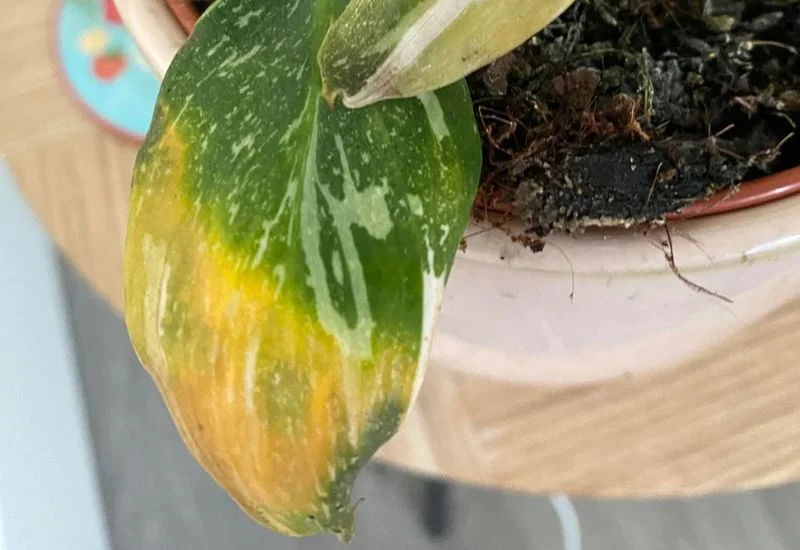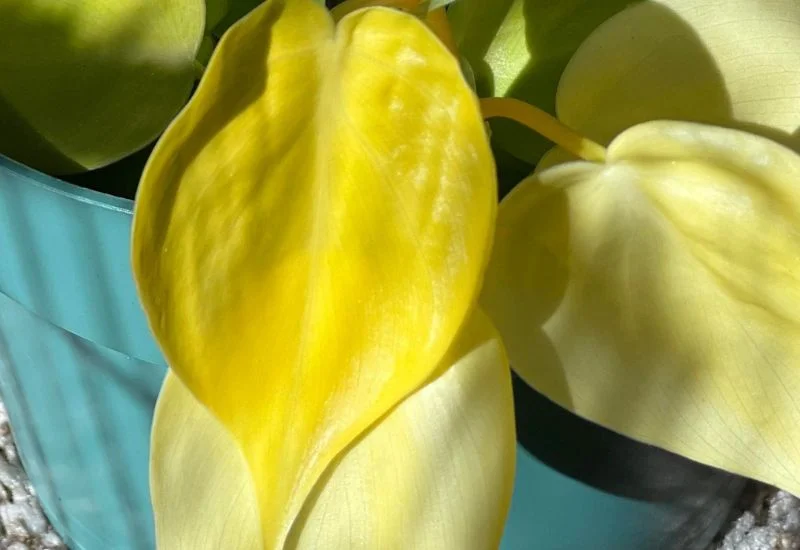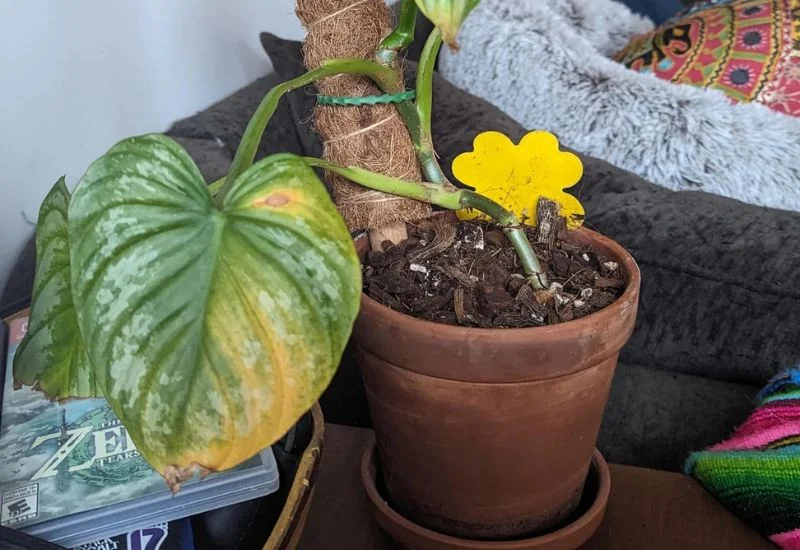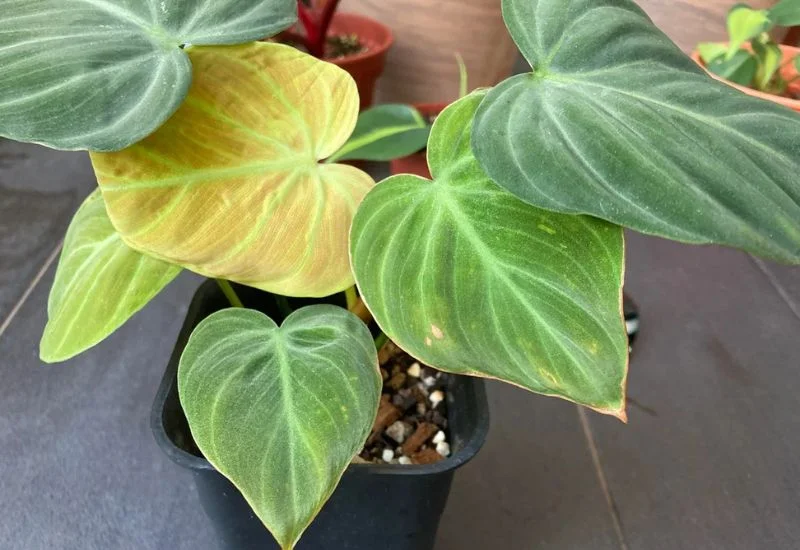Yellow leaves in plants especially in philodendron are one of the very common problems. But understanding its causes and taking proper actions can solve this issue.
In this post, I’ll cover the causes of philodendron yellow leaves, and brown spots, and preventive measures.
Understanding Philodendron Yellow Leaves

The yellow leaves of the philodendron are common. The leaves grow as sprouts and then mature. They help in photosynthesis and with age, they get yellow and die off.
The philodendron leaves are bright and vibrant, depending on the species. If the younger leaves start to turn yellow, then it’s a sign of distress. There can be different reasons for yellow leaves. The reason can be underwatering, overwatering, over-fertilization, and many more.
Common Causes of Yellowing Leaves in Philodendrons
Improper Watering Practices
The most common reason for yellow leaves is underwatering or overwatering. The overwatering causes the leaves to look squashy at first, and then they turn yellow. Overwatering can cause other problems, such as root rot.
Underwatering can also cause stress to the plant. As a result, the leaves of the plant turn yellow. Watch the watering schedule.
Tips For Proper Watering Techniques
Before watering the plant, check the soil using your fingers or a moisture meter. Do not let the soil dry out completely. After watering the plant, make sure there is no excess water left. Check the drainage hole of the pot.
Lighting Issues
Philodendron plants can adapt to different light conditions. But huge changes in the light can cause yellow leaves.
Direct Sunlight
Philodendrons prefer bright but indirect sunlight. Direct exposure to light or too much light can scorch the leaves. It can turn leaves crispy and yellow. Place the plant in a location where indirect sunlight is available.
Low Light

The philodendrons can survive in low light. The prolonged period of low light can stunt their growth. It also causes yellow leaves. Place the plant into bright indirect light. If you do not have the perfect spot, you can use LED grow lights for the plant.
Nutrient Deficiencies
Philodendrons need balanced nutrients to thrive. Deficiency in nutrients can cause several problems, such as yellow leaves. Check the soil pH to see the nutrient amount. Provide your plants with nutrients.
Environmental Stress
Philodendron plants prefer the temperature between 65 °F to 85 °F. The preferred humidity level is 40% to 60%. Temperatures below 65 °F and higher than 85 °F can cause environmental stress to the plant. Place the plant where there is no sudden fluctuation in temperature. Check the temperature and maintain the humidity level as per plants’ needs. Environmental stress can cause discoloration of plants and yellow leaves.
Pest Infection
The other common reason for yellow leaves can be pest infection. Common bugs such as mealybugs, scales and spiders like to absorb moisture. As a result, the plant’s leaves turn yellow. To prevent any pest infection, inspect the plant daily. If found, treat them right away.
Brown Spots on Philodendron Leaves

Philodendron plants are famous for their beautiful, vibrant colors. The brown spots on their leaves can be due to different reasons. The reasons can be overwatering, underwatering, more exposure to the sun, and fertilizer burn.
Common Causes of Brown Spots in Philodendrons
Watering issues
Underwatering and overwatering can be the reason for brown spots on your leaves. Overwatering can cause fungal infections such as root rot and brown spots on the leaves. The symptoms can be an unpleasant smell from the soil.
Underwatering can make the leaves of the plant brown. It’s a sign of tissue death due to dehydration.
Watering Techniques
- Before watering, check the soil with a moisture meter
- Let the soil get dry first before watering
- Instead of following a schedule, water the plant as per the need
- Improve drainage to prevent waterlogging
Fungal Infections
Here are the most common fungal infections that cause brown leaves:
Leaf spot Diseases
This is the most common fungal disease. It is due to fungi such as Phyllosticta, Xanthomonas, and Alternaria. The infected leaves display small brown and black spots. This spot gets dark as they mature. These spots make a yellow halo around them. The leaves turn brown and at last, die off.
Root Rot
Another common disease is root rot. It is due to fungi such as Pythium, Phytophthora, or Fusarium. It causes an unpleasant smell in the soil and brown leaves.
Preventive Measures
- Improve the air circulation around the plant
- Maintain the right light exposure to prevent the growth of fungi
- Adjust the watering habit
- Avoid overwatering and underwatering
- Inspect the plant daily to identify and treat any signs of residual fungi promptly
Nutrient Deficiencies

Nutrient deficiencies such as calcium and magnesium cause leaves to turn brown. To prevent nutrient deficiency, test the soil regularly. It will help check the nutrient level so that you can take action in time. Check the pH of the soil. If the pH is not as per the plant’s needs, it can block the essential nutrients.
Environmental Stress
Sudden changes in the environment of the plant can put your plant under stress. Here are the environmental factors impacting the health of plants:
Change in temperature
The required temperature for philodendron is 65 °F to 85 °F. A sudden drop or rise in the temperature can make brown spots on the leaves.
Do not place your plant near cold windows or heating systems. The temperature can fluctuate around the plant.
Change in Humidity
Philodendrons prefer 60% to 80% humidity levels. Dry air and less moisture can make leaves brown. Increase the humidity around the plant. You can place a plant humidifier or a tray filled with pebbles and water to increase humidity.
Preventive Measures
- Check the temperature and humidity level of the plant. You can use a thermometer and hygrometer.
- Change in location can also cause environmental stress; allow acclimation time
- Clean the leaves of the plant so that photosynthesis works fine
Preventive Measures

Adjust the watering habits to fit the needs of the plant. Let the soil get dry between watering. Adjust the watering schedule according to the season. Before watering, check the moisture level of the soil.
Place the plant in bright but indirect sunlight. Both low light and excessive direct light can cause discoloration. If you do not have a good spot, place artificial lights on the plant. Check the pH of the soil to check nutrient requirements.
Add fertilizer only in spring and summer. Overuse of fertilizer can also cause yellow leaves. Try to maintain a stable environment around the plant. Sudden change and fluctuation in the environment can cause yellow leaves.
watch the plant after watering. Avoid overwatering. Make sure the drainage hole of the pot is working fine. The unwanted stay of water can cause different fungal problems.
Here you have it:
Causes of philodendron yellow leaves and brown spots.
Hope you enjoyed the post.
